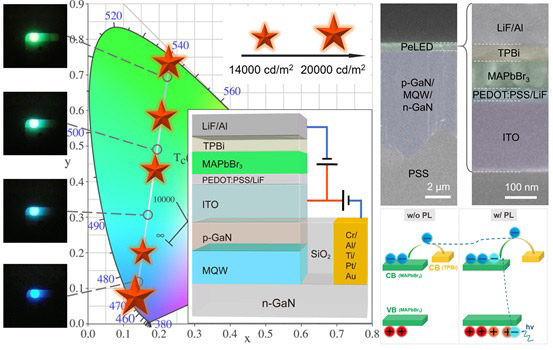News: LEDs
15 June 2022
Perovskite–GaN tandem LED with improved tunable luminance and color
In conventional display panels, the red, green and blue sub-pixels are assembled in a side-by-side structure, which intrinsically leads to a large pixel area, making it difficult to fulfill the requirements of applications requiring ultra-high display resolution, e.g. advanced high-dynamic-range (HDR) and virtual-reality (VR) displays, notes the South China University of Technology. An efficient approach to reducing the pixel area is to combine two (or even three) colors (red, green or blue) within one sub-pixel. However, this requires excellent color tunability for the lighting device. To meet this demand, multi-color electroluminescence (EL) devices with a tandem structure are becoming a straightforward solution to improve space utilization.
In particular, tandem structures with different subpixels are promising for perovskite-based multi-color EL devices in ultra-high-resolution full-color displays. However, considering the low brightness and stability of blue perovskite light-emitting diodes (PeLEDs), realizing excellent luminance- and color-independent tunability remains a challenge.
To overcome this, Li Zongtao and Li Jiasheng at South China University of Technology have fabricated a tandem structure in which a bright and stable blue gallium nitride (GaN) LED has been vertically integrated with a green MAPbBr3 (methylammonium lead bromide) PeLED, achieving a Pe–GaN tandem LED with independently tunable luminance and color.

Picture: Diagram showing the tandem LED, LED structure, LED performance and EPCE effect.
The electronic and photonic co-excitation (EPCE) effect is found to suppress the radiative recombination and current injection of PeLEDs, leading to degraded luminance and current efficiency under direct-current modulation. Accordingly, pulse-width modulation (PWM) is introduced to the tandem device with a negligible EPCE effect, and the average hybrid current efficiency is significantly improved by 139.5%, finally achieving record tunable luminance (average tuning range of 16631cd/m2 at an arbitrary color from blue to green) for perovskite-based multi-color LEDs (Li Zongtao et al, ‘Perovskite-Gallium Nitride Tandem Light-Emitting Diodes with Improved Luminance and Color Tunability’, Advanced Science (2022), 2201844).
The reported independent tunability can be the starting point for perovskite-based multi-color EL devices, enabling the combination with matured semiconductor technologies to facilitate their commercialization in advanced display applications with ultra-high resolution, believe the researchers.








